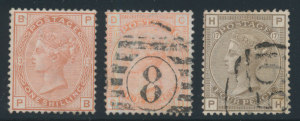A popular specialty of fifty years ago is well worth considering. It is collecting the early stamps of Great Britain by check letter. The Nineteenth Century stamps of Great Britain were mostly printed in sheets of 240. This was done because most of the stamps printed were one penny stamps which, in the pre-decimal period of English money, meant that 240 pence equaled a pound. Postal clerks found their daily accounting of stamp sales and money taken much easier when sheets of stamps readily broke into pound divisible units.
Stamps were issued in these large sheets and each stamp in the sheet had differing check letters for AA at the top left stamp printed in the sheet to TL at the bottom right. Anyone looking at a single stamp could know instantly exactly where in the sheet that it came from. Check letters made postal accounting easier (looking in his drawer and seeing that he sold all the stamps from a sheet up to say position BA, a clerk would know that he had 228 stamps left in his drawer). More importantly, reuse of postage stamps after canceling was a concern and check letters made it very difficult to cut uncanceled portions of used stamps and paste them together for reuse (this is why the letters were reversed at the bottom of the stamps from the top-it made such reuse even more difficult).
Collecting GB stamps by check letter used to be a popular specialty. But after WWII, Nineteenth Century GB stamps rose in price and collectors found this specialty expensive. Recently, the disconnect between classic GB catalog values and selling prices for larger accumulations of check letter stamps has become profound and collectors can buy many of these stamps in plating groups, in decent quality, at well under 10% of Scott catalog value. Stamp collectors who also enjoy jig saw puzzles and cross word puzzles also seem to enjoy making pages where there are 240 spaces for the various check letter positions of the stamps that they collect and trying to fill them in. Collections of this type often have enormous catalog values and have cost their owner relatively little.


